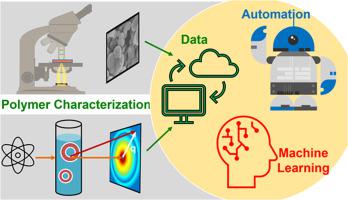当前位置:
X-MOL 学术
›
Prog. Polym. Sci.
›
论文详情
Our official English website, www.x-mol.net, welcomes your
feedback! (Note: you will need to create a separate account there.)
Machine learning for analyses and automation of structural characterization of polymer materials
Progress in Polymer Science ( IF 26.0 ) Pub Date : 2024-05-03 , DOI: 10.1016/j.progpolymsci.2024.101828 Shizhao Lu , Arthi Jayaraman
Progress in Polymer Science ( IF 26.0 ) Pub Date : 2024-05-03 , DOI: 10.1016/j.progpolymsci.2024.101828 Shizhao Lu , Arthi Jayaraman

|
Structural characterization of polymer materials is a major step in the process of creating materials' design-structural-property relationships. With growing interests in artificial intelligence (AI)-driven materials design and high-throughput synthesis and measurements, there is now a critical need for development of complementary data-driven approaches (e.g., machine learning models and workflows) to enable fast and automated interpretation of the characterization results. This review sets out with a description of the needs for machine learning specifically in the context of three commonly used structural characterization techniques for polymer materials: microscopy, scattering, and spectroscopy. Subsequently, a review of notable work done on development and application of machine learning models / workflows for these three types of measurements is provided. Definitions are provided for common machine learning terms to help readers who may be less familiar with the terminologies used in the context of machine learning. Finally, a perspective on the current challenges and potential opportunities to successfully integrate such data-driven methods in parallel/sequentially with the measurements is provided. The need for innovative interdisciplinary training programs for researchers regardless of their career path/employment in academia, national laboratories, or research and development in industry is highlighted as a strategy to overcome the challenge associated with the sharing and curation of data and unifying metadata.
中文翻译:

用于聚合物材料结构表征分析和自动化的机器学习
聚合物材料的结构表征是创建材料的设计-结构-性能关系过程中的一个重要步骤。随着人们对人工智能 (AI) 驱动的材料设计以及高通量合成和测量的兴趣日益浓厚,现在迫切需要开发互补的数据驱动方法(例如机器学习模型和工作流程),以实现快速和自动化的解释的表征结果。这篇综述描述了机器学习的需求,特别是在聚合物材料的三种常用结构表征技术:显微镜、散射和光谱学的背景下。随后,对这三种类型的测量的机器学习模型/工作流程的开发和应用所做的著名工作进行了回顾。提供了常见机器学习术语的定义,以帮助可能不太熟悉机器学习上下文中使用的术语的读者。最后,提供了对当前挑战和成功将此类数据驱动方法与测量并行/顺序集成的潜在机会的看法。强调为研究人员提供创新的跨学科培训计划,无论他们在学术界、国家实验室的职业道路/就业,还是在工业界的研究和开发,作为克服与数据共享和管理以及统一元数据相关的挑战的战略。
更新日期:2024-05-03
中文翻译:

用于聚合物材料结构表征分析和自动化的机器学习
聚合物材料的结构表征是创建材料的设计-结构-性能关系过程中的一个重要步骤。随着人们对人工智能 (AI) 驱动的材料设计以及高通量合成和测量的兴趣日益浓厚,现在迫切需要开发互补的数据驱动方法(例如机器学习模型和工作流程),以实现快速和自动化的解释的表征结果。这篇综述描述了机器学习的需求,特别是在聚合物材料的三种常用结构表征技术:显微镜、散射和光谱学的背景下。随后,对这三种类型的测量的机器学习模型/工作流程的开发和应用所做的著名工作进行了回顾。提供了常见机器学习术语的定义,以帮助可能不太熟悉机器学习上下文中使用的术语的读者。最后,提供了对当前挑战和成功将此类数据驱动方法与测量并行/顺序集成的潜在机会的看法。强调为研究人员提供创新的跨学科培训计划,无论他们在学术界、国家实验室的职业道路/就业,还是在工业界的研究和开发,作为克服与数据共享和管理以及统一元数据相关的挑战的战略。






























 京公网安备 11010802027423号
京公网安备 11010802027423号